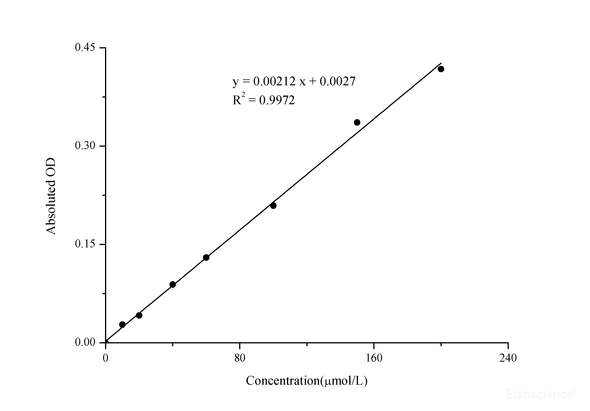Elabscience
Inhibition And Production Of Superoxide Anionic Colorimetric Assay Kit (WST-1 Method)
- SKU:
- E-BC-K001-M
- Weight:
- 0 KGS
- Shipping:
- Calculated at Checkout
Description
Detection principle
Superoxide anion free radicals are produced through the reaction system of xanthine and xanthine oxidase. WST-1 (a water-soluble tetrazolium salt) can react with the generated superoxide anion to produce water-soluble formazan. When the tested sample contains the superoxide anion free radical inhibitor, it can inhibit the formation of formazan. When the tested sample contains the substance that produces superoxide anion free radical, it can promote the formation of formazan dye. By colorimetric analysis of WST-1 products, the units of activity of inhibition or production of superoxide anion radical in samples can be calculated.
Performance characteristics
| Sample type | Serum,plasma,urine,cells,cell culture supernatant,leucocyte |
| Detection method | Colorimetric method |
| Assay type | Activity |
| Assay time | 35 min |
| Precision | Average inter-assay CV: 5.8%Average intra-assay CV: 2% |
| Other instruments required | Micropipettor, Multi-channel pipettor, Incubator, Vortex mixer, Centrifuge |
| Other reagents required | Normal saline (0.9% NaCl), PBS (0.01 M, pH 7.4) |
| Storage | Reagent 3: -20℃, others: 2-8℃ |
| Valid period | 6 months |
Dilution of sample
Before the formal experiment, it needs to choose 2-3 samples for diluting a series of diluent and determine the dilution factor when the SOD inhibition ratio is 30%~65% (the optimal inhibition ratio is the range of 40%~60%).
Inhibition ratio=[(A1-A2)-(A5-A6)]×100%/(A1-A2)
Adjust sampling volume: If inhibition ratio > 65%, need to dilute the sample or decrease the sampling volume than take the test. If inhibition ratio < 30%, need to increase the sampling volume.
The recommended dilution factor for different samples is as follows (for reference only):
|
Sample type |
Dilution factor |
|
Human serum |
4-7 |
|
Mouse serum |
15-25 |
|
Rat serum |
25-35 |
|
Human saliva |
1 |
|
HepG2 culture supernatant |
1 |
|
10% Rat brain tissue homogenate |
150-200 |
|
10% Rat liver tissue homogenate |
500-600 |
|
10% Mouse liver tissue homogenate |
500-600 |
|
10% Mouse heart tissue homogenate |
150-200 |
|
10% Epipremnum aureum tissue homogenate |
20-30 |
Note: The diluent is normal saline (0.9% NaCl) or PBS (0.01 M, pH 7.4).
Additional Information
Detection method: |
Colorimetric method |
Detection instrument: |
Microplate reader(440-460 nm,optimum wavelength: 450 nm) |












